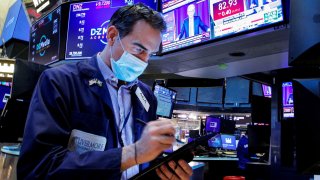
- A 25-basis point interest rate hike on Wednesday from the Federal Reserve was the first since 2018.
- But Chair Jerome Powell's outlook and the Fed's projections for GDP, inflation and future rate hikes say more about the future path of the economy and risk of recession amid new risks from war in Ukraine, according to Kathy Bostjancic, chief U.S. economist at Oxford Economics.
- The Fed is now forecasting six more rate hikes and inflation at over 4%, a significant increase in its inflation outlook.
The Federal Reserve raised its benchmark interest rate for the first time since 2018, but it's already time for the market to look past this well-telegraphed move, according to Kathy Bostjancic, chief U.S. economist at Oxford Economics.
While there are complicating factors such as the war in Ukraine, the most prominent issue for the Fed is that economic growth remains quite strong. If the Fed is shy about raising rates and reducing the balance sheet because of war, there is a risk that it gets even further behind on inflation, Bostjancic says. Consumers are still sitting on a high level of savings and benefitting from rising wages, and if the Fed gets further behind the curve on inflation by waiting, it will only increase the risk of the central bank becoming more hawkish later on.
The Fed forecast six more rate hikes and tellingly, its view of inflation's trajectory moved up considerably, with a forecast now above 4% this year.
Get New England news, weather forecasts and entertainment stories to your inbox. Sign up for NECN newsletters.
There are risks on both sides of the Fed equation. If it is too hawkish and tightens too quickly, that can send the financial markets into a convulsion and lead to a mass selling of risk assets which feeds back into the real economy. Recent action in the bond market showing a narrowing of the spread between the two-year and 10-year treasuries stoked fears of an inverted yield curve, which is a signal that this worst-case, recessionary scenario could play out.
After the Fed announcement on Wednesday, yields rose to their highest levels since 2019.
Recession is not the base case for Bostjancic, even if she says the Fed won't be blind to these signals.
Money Report
Fed Chair Jerome Powell indicated during recent testimony that he sees inflation running a little faster than the Fed's previous expectation, and any adjustment from the Fed is significant, Bostjancic said. Her view of the inflation outlook into the meeting was much higher than the median forecast of 2.7% year over year through Q4 2022 — closer to 4% than 3%, and that has now been matched by the Fed. Her view is based on a labor market that is strong and a consumer that is resilient, and the Fed being behind the curve on inflation already.
"It is high and elevated and rising at a rapid pace," she said. "The Fed has to worry about inflation. We're not talking about just 3%. It's close to 8%. This is a massive overshoot."
The "dot plot" and the Fed's economic projections for GDP and inflation will need to be digested by the market, and the Dow pared gains initially after the Fed's announcement, but stocks ended much higher on Wednesday afternoon with the S&P 500 notching a gain of over 2%. Ultimately, it's how Powell frames the Fed thinking on Wednesday that matters most.
"I want to hear how he handicaps the risks around growth and inflation. That will tell me something about the Fed's reaction function and that is the forward guidance," Bostjancic said.
Powell said in his remarks after the official announcement, as he had said after the last FOMC meeting, that the risk to inflation remains to the upside. Though Powell said he does not see signs of a wage-price spiral and wage gains are already showing signs of moderating. The Fed expects unemployment to end the year holding at 3.5%, according to its latest forecast.
While oil prices and the pain at the pump, which eased this week, caught the market's attention amid the outbreak of war in Europe, Bostjancic says food prices have double the weight of energy in the consumer price index and loom as an even larger factor in the inflation outlook — and are not immune to war. Commodities prices rising sharping are likely to get worse because of Russia's invasion of Ukraine, which impacts the production of wheat, among other commodities, and will reverberate through the global supply chain and "turbocharge food prices even higher," she said.
Powell has already said rate hikes are coming, in spite of the outbreak of war.
Oxford Economics is in line with a market view of 175 basis points of total tightening by the Fed this year, but isn't sure whether those hikes remain limited to 25 basis points or include the potential for a 50 basis point hike at some point. One FOMC member, James Bullard of the St. Louis Fed, voted for a 50 basis point hike at this meeting.
"Our view is that the economy is strong enough and demand still strong enough that even with the impact from war we still see growth at 3% or higher this year, so the Fed needs to get to a neutral rate as quickly as possible without destabilizing the market," Bostjancic said.
The situation is not "dramatically different" for the U.S.," she said. The U.S. economy is not immune to the war, but compared to Europe's economy, it is much better insulated. "I don't think Ukraine necessarily slows the economy enough to take the edge off inflation," she added.
The Fed did lower its GDP outlook for the year, from 4% at its last meeting to 2.8%, with the Ukraine war being cited as factor, and while the central bank anticipates higher inflation and more rate hikes to combat it.
Powell will need to provide a view on where his concern primarily lies — how does the shock of this war impact the U.S. economy versus the shock on the inflation side and the growth side, and the market will be looking closely for any signals from the Fed chair on what he emphasizes more in the risk analysis.
But in the end, Bostjancic says, "The Fed has to come in. It can't control the war even if there is a knock-on effect in supply chains and scarcity of food and oil occur."
There is also no way for a central bank to project the potential for a ceasefire in war.
Even in Europe, the ECB recently showed itself to be more hawkish in inclination, holding rates but saying it would wind down stimulus sooner rather than later. "They need to fight inflation even if growth is slowing," Bostjancic said, and the ECB's recent policy views match an outlook on the Fed that suggests it can be more hawkish even in the face of larger uncertainty.
The war could potentially delay the Fed's balance sheet runoff, but by a month or two, and in her view, it should not alter the general path of normalization of both rates and the Fed's holdings in the bond market.
Powell indicated in his press conference that the Fed was moving ahead on the balance sheet reduction plan and may stick with May. He described "exceptional progress" in the discussions among FOMC members and added that the balance sheet unwind could begin at the next meeting in May.
"The framework is going to look very familiar to people who are familiar with the last time we did this," he said. "But it will be faster than the last time and of course it's much sooner in the cycle than last time."
While this week's producer price index showed a slight undershoot of the inflation expectation and the latest wage inflation reading came down, the recent flow of data has reinforced that the inflationary pressures are still widespread and elevated, and the Fed needs to raise rates and has the ability to raise in a significant way. "They have to come in and cool things off," Bostjancic said.
Powell said in his press conference after the rate hike announcement that the risk of recession isn't particularly elevated — this week's CNBC Fed Survey put the risk at 1 in 3 — and the economy is strong, and inflation will come down eventually. The median inflation projection among FOMC members is 4.3% for the year, and the forecast through 2024 is "notably higher" than previous Fed projections, Powell noted.
"It may take longer than we like but I'm confident that we'll use our tools to bring inflation down," Powell said.
The market has already priced in an aggressive rate hike profile, and the market was not expecting the Fed to tell it to price in less than it already has. "The market is already in tightening conditions without the Fed having to do it. It's doing the work for the Fed," she said.
The Fed matched that view on Wednesday.






